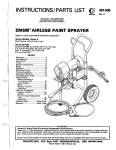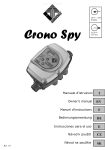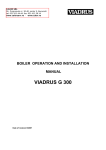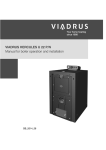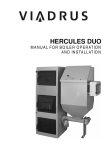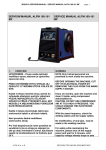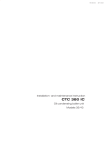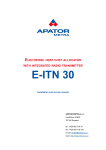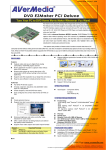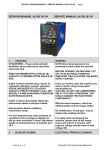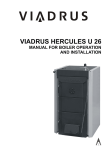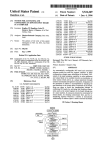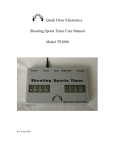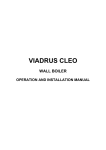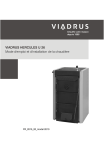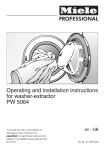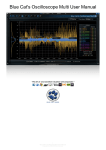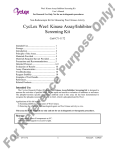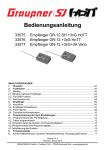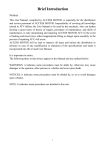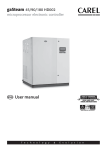Download VIADRUS G 700
Transcript
MANUAL FOR ASSEMBLY OF BOILER VIADRUS G 700 1 Dear Client: We appreciate your confidence in our firm ŽDB a.s. Bohumín, Heating Technology Plant VIADRUS and, we would like to thank you for purchasing Gas fired Boiler VIADRUS GLADIATOR G 700. In order to get used to a correct handling with Your new product, please kindly read and get acquainted with a Guide for Use (primarily with the Chapter No.8 – Boiler Attendance by User). We would appreciate if you could kindly adhere to the following information and the Publication No. 91/93 Col. issued by the Czech High Authority on Work Safety for ensuring the safe operation in the low temperature boiler rooms; this in turn should ensure to you a trouble free operation of the boiler over many years, to yours and our satisfaction. Gas fired boiler VIADRUS G 700 was approved for operation in the Czech Republic: by the following attest from the Machinery Testing Institute, State Testing Laboratory No. 202, Brno: Certificate ES for Testing the style as per Standard ES 90/42/EHS No. E – 37 – 00715 - 03 Certificate ES for Testing the style as per Standard ES 90/396/EHS No. E – 37 – 00723 - 03 Certificate as per guidance 73/23/EHS No. E – 37 – 00721 - 03 Certificate as per guidance 73/23/EHS No. E – 30 – 00724 - 03 Certificate as per guidance 89/336/EHS No. E – 37 – 00722 - 03 Certificate as per guidance 89/336/EHS No. E – 30 – 00725 - 03 Certificate No. B – 30 – 00726 - 03 2 Contents: ORDER 4 1. BOILER USES AND ADVANTAGES 5 2. BOILER TECHNICAL PARAMETERS 6 3. DESCRIPTION 7 3.1. Boiler Construction 7 3.2. Placement and Installation Table 3 Highest Allowable Limits for Heating Water as per ČSN 07 7401:1992 Code. 4. BOILER INSTALLATION 10 11 12 4.1. Boiler Body Installation 12 4.2. Pressurizing boiler vessel 14 4.3. Boiler Armature Installation 4.3.1. Installation of the closing plate and a flange for burner 14 14 5. BOILER JACKETING 17 6. ELECTRICAL PANEL – BASIC STYLING 18 7. BURNER INSTALLATION 19 8. GUARANTEE AND LIABILITY FOR DEFECTIVE GOODS 12 3 Order Order Specification Code (type designation) G 700 X X X X Number of links: 10: 10 links 11: 11 links 12: 12 links 13: 13 links 14: 14 links 15: 15 links Regulation Type: 4: 6: OS 04 OS 06 Delivery status: S: assembled R: disassembled Burner type: 0: no burner 1: with burner In your order, it is necessary to specify parameters as per the requisite specification Code. 4 1. Boiler Uses and Advantages Single-tier cast iron link hot water boiler with supercharged combustion chamber, direct heating is designed for central heating on the basis of gaseous (natural gas) and liquid fuel (extra light heating Oil) Supercharged burners used in combination with boiler must be designed to conform with: ČSN EN 676 : 2000 – Gaseous fuel burners with ventilators and automatic regulation ČSN EN 267 : 2000 – Liquid fuel burners with ventilators ČSN EN 303-1:1999 – Boilers for central heating equipped with burners and ventilators ČSN EN 303-2:1999 – Boilers for central heating equipped with burners and ventilators ČSN EN 303-3:1999 – Boilers for central heating equipped with burners and ventilators Boiler is manufactured exclusively for low pressure water systems of central heating, up to a maximum operating temperature of heating water 90 deg C (optionally up to 115°C), minimum operating temperature of heating water 60°C at maximumworking overpressure 4 bar. The boiler vessel is tested at overpressure of 8 bar. Advantages are: 1. high longevity of the cast-iron boiler body 2. Highly economical operation Over the whole power rating ranges, the fuel burning efficiency is higher than 91,5 % for all kind of fuels 3. As per wishes of the client, order supplied with burner 4. contemporary design 5. Fully automatic two step operation 6. Signalization during operation and failure announcement; signals could be eventually transferred to the supervisory regulation system 7. Boiler could be controlled with aid of supervisory automatics or, space sensor of temperature 8. Depending on the boiler room disposition, closure plate opening could be towards left or right side 9. Easily accessible viewing glass and the probe for overpressure measurement in the combustion chamber 10. When used with burners recommended by the manufacturer (see Chapter “Boiler Technical Parameters”), boilers of this sort are regardful of environment because the fuel combustion products strictly conform to the demanding ecological standards and regulations. 5 2. Boiler Technical Parameters Table 1 Thermo – technical Parameters of the Boiler (Fuel: Natural gas H, heating oil extra light) Boiler size (number of links) pc 10 Nominal power Lower step Power Power Intake range Minimum efficiency Range of temperatures regulation Fuel consumption – natural gas - diesel fuel, heating oil kW kW kW % °C m3/h Kg/h 330 400 470 550 650 750 In accordance with a range of selected burner type 360 438 512 591 710 820 91,5 60 – 90 (optionally 115) 36,1 43,9 51,4 60,2 71,1 82,3 30,2 36,8 43,1 50,5 58 65,5 Fuel Mass flow 0,088 Combustion products temperature Combustion products temperature I. Step Combustion products routing volume Depth of combustion chamber Volume of combustion chamber Heat transfer surface Pressure loss on the combustion products side Recommended smokestack draught Volume of boiler water space Kg/se c °C °C dm3 mm dm3 m2 mbar mbar L Pressure loss on the water side – dt = 20 K - dt = 10 K Stand by Loss Maximum working overpressure mbar mbar kW bar Dimensions - width - height - depth Heat transfer media Connections Diameter of the smoke exhaust sleeve Burner flange (boiler part) – H70 Burner connection dimensions mm mm mm mm mm mm mm Boiler Mass Kg 1660 1815 1970 2125 2280 2430 Boiler size (number of links) Recommended Burners NATURAL GAS, BIOGAS pc 10 11 12 13 14 15 INTERCAL BENTONE WEISHAUPT PBS Třebíč DUNPHY 11 12 13 14 15 0,10 0,12 0,135 0,156 0,180 610 1377 314 21,35 0,9 676 1527 347 23,8 1,4 874 1977 447 31,14 5 940 2127 480 33,58 6,2 252 277 165 - 190 130 742 808 1677 1827 381 414 26,26 28,7 2,2 3,2 Min. 0,2 302 327 352 377 0,9 3,4 0,89 1,35 3,9 0,95 2,6 8,6 1,06 3,34 12,4 1,11 4,2 16,7 1,16 2442 2442 2592 1,9 5,3 1 4 904 1424 1842 2142 2142 100 250 300 220 Given in the documentation of the selected burner type SGN SGN 77/2 SGN 77/2-350 88/2 BG 450 2 BG 550 BG 650 – 2 (M) BG 450 M – 2 (M) BG 450 BG 550 LN BG 600 BG 700 LN LN LN WG 40 N/1 - A G 5/1 – D (LN) APH-M 04 PZN, APH-M 04 PZN, PPN, PZ PPN, PZ TG05.100 HL (MP) Recommended Burners LIQUID FUEL INTERCAL (fa ESK Brno) SL 77/2 SL 88/2 CUENOD (fa ESK Brno) BENTONE WEISHAUPT B 45 A2.2 WL 40-A 6 B 55 – 2 L3 Z-A CUENOD C. 100 H 201 B 65 – 2 Gas flow data are for gas temperature of 0 °C and atmospheric pressure of 1013,25 mbar To adjust for actual temperature and pressure, the following formula may be used.: 1013,25 . (273 + t) V = VE . ---------------------------------------- p . 273 V VE t p. 273 - Gas volume at given pressure and temperature Gas volume at 0°C and 1013,25 mbar Gas temperature (°C) Absolute gas pressure (mbar) Absolute temperature (K) 3. Description 3.1. Boiler Construction Boiler body (see Figure 1 – individual positions) is composed of links with aid of pressed inserts that are secured by anchor bolts. The design of the boiler provides for three-draught construction, whereby the links create the combustion space and convection part, inside is then actual water space of the boiler. To seal the boiler, a sealing cord is placed into a groove along the perimeter of individual links and combustion chamber, enforced by the silicone binder applied onto grooves in places where connection between links is created after the whole boiler body is tightly bonded together. The front link is furnished with an insulated closure plate that could be made to open left or right. This must have corresponding hinges and closures installed. The burner flange is a part of the closure plate. On the flange, there is a viewport with a probe for measuring the overpressure in the combustion chamber. The opening φ 126 mm in upper part of front link is closed by means of a flange to accommodate a well, via predrilled 3 x G ½:“, for thermostat, safety thermostat and thermometer, and a return check valve of the manometer . φ 126 blanked by the blind flange.. Intake and take off of the heating media is situated on the rear link; furnished with flanges and sleeve DN 100 as well as a companion flanges DN 100. The draining tap G ¾“ is situated on the lower sleeve. The flange equipped with sleeve for intake of heat carrying substance has also a delimiting insert part. On the casting above the lower flange with sleeve, there is external ground safety contact for the boiler. In both, upper and lower part of the rear link there are four cleaning dishcovers. Combustion products are exhausted through the exhaust throat placed on the combustion products collector. Below the exhaust throat, there is an explosive shutter with a holder. On the smoke exhaust sleeve, there are measuring places for temperature and analyzer of the effluent. The whole boiler body is perfectly insulated by plates made of mineral wool having 100 mm thickness. The steel jacket of the boiler is hanged upon two consoles of the shroud, situated besides the upper anchoring bolts. Surface treatment is performed by painting with comaxite paint. Electrical panel is situated in the front part of the boiler, and it houses all switching, regulatory and security elements as well as their interconnecting terminals. 7 8 Figure 1 – Boiler Assembly Dwg. 1. Front link 2. insert 3. Middle link 4. Rear link 5. Effluent collector 6. Cleaning lid 7. Sealing cord 8. Explosive shutter 9. closure 10. Insulated closure plate 11. hanger 12. Insulated burner plate 13. Viewport w. probe 14. flange 170x170 w. drillings 3x G1/2“ 15. Electropanel console 16. Flange 170 x 170 17. Distributing pipe with sleeve 18. Return water flange 19. Companion flange 20. Heating water flange 21. Anchor bolts: 22. Jacket console 23. Connectors console 24. casing part left front 25. casing part right front 26. Side part of cover. 27. Side part of cover rear. 28. Front part of jacket portion 2. right 29. Front part of jacket portion 2. left 30. upper front part of the jacket 31. upper rear part of the jacket 32. Upper jacket part 33. Rear portion upper and lower 34. Rear part of cover middle 35. Draining tap 36. Return valve of thermomanometer 37. Thermostat wells and capillaries Of thermometer 38. large blind 39. blind with a thermomanometer 40. Power module 41. Front jackef lid 42. Electrical panel lid 43. casing part front right 44. Process clock 3.2. Placement and Installation Boiler VIADRUS G 700 is supplied in a disassembled state, i.e. individual links on palette, boiler armature and auxiliaries in proper packaging container, jacket and insulation also in the packaging case. Boiler is designed for placing in enclosed spaces having low up to middle aggressive environment; from the point of view of electro-technical regulations the surroundings just ordinary (ČSN 33 2000 – 7 – 701:1997). It is also suitable for use in spaces separated from the actual residential environs prostoru (Notice 91/93 Col.., ČSN 07 0703:1986 Gas Boiler Plants). Boiler operates at noise level not exceeding level LA = 85 dB(A) (the actual magnitude depends on the type of burner used: For the recommended types it ranges between 60 – 70 dB). Boiler must be build on non-flammable liner or on a bedding about 50 mm high. A non-encumbered space must be left in front of the boiler to allow manipulations, this must be the depth of the boiler + 500 mm minimum, from the side 600 mm (to allow access to the rear), in the back 800 mm and between two boilers a space of 500 mm should be kept. Above all for boiler placement it is necessary to respect the disposition requirements for selected type of the burner (gas intake, etc.) The space distance L in front of the boiler as per the following figure, is specified for case of cleaning the boiler by mechanical brush. If the clean up maintenance is to be done by chemical means, the distance dependes again on the type of selected burner. 10 Je nutné respektovat dispoziční požadavky zvoleného typu hořáku (přívod plynu, délka hořáku, etc.) – It is necessary to respect placement requirements according to selected burner type (gas inlet, length of burner, etc.) Figure 2 – Boiler Placement in Boiler Room Filling of the heating system by water First, the whole heating system must be thoroughly flushed to cause removal of all impurities that may be deposited in the distributions or heating bodies and could subsequently become a source of pump damage. To fill the boiler and heating system, it is necessary to use clear, colorless water, free from foreign matter in suspension, without any oil or chemically aggressive substances. Circulating and replenishing water must correspond to: Table 3 Highest Allowable Limits for Heating Water as per ČSN 07 7401:1992 Code. Hardness Ca2+ Total concentration of Fe + Mn *) recommended value mmol/L mmol/L mg/L 1 0,3 3* In case the hardness be outside of the specifications, water must be conditioned.. Experience shows that even multiple reheat of the hard water will not prevent deposition of salts on interior surfaces of the boiler vessel. Deposits of about 1 mm thick (limestone) will cause a loss of heat transfer from metal to water of about 10%. During the heating season, a stable level of water volume in the system must be ensured while being mindful that the heating system must be periodically de-aerated. Boiler and heating system water must never be discharged or bled from the system save for urgent and necessary situations such as maintenance, etc. Bleeding the conditioned water from the heating system and refilling it with new water is always associated with danger of an increased corrosion and calcite deposit formation. Should it be necessary to refill the water in the heating system, it is permitted only when the boiler is let to cool; this will prevent a potential crack failure of castiron links. 11 4. Boiler Installation 4.1. Boiler Body Installation List of parts needed − Boiler links front, rear, and appropriate number of middle − Requisite number of boiler inserts − Sealing cord (appx. 6m/link) − Anchor bolts: 4 pc w. gussets − Oil paint for painting boiler inserts − Bolt with an eye 4 pc − Flange 170x170 w. drillings 3xG ½” − Flange 170x170 blind 3 − Well of capillary thermometer − Well for I. and II. Step boiler thermostats And security − Checkvalve of manometer − Silicone sealant/binder (from manufacturer) − Flange of heating water with sleeve − Flange of return water with sleeve − Distribution pipe − Companion flange 2 pc 10 8 18 53 1480 11 9 20 59 1630 Links number 12 13 10 11 22 24 65 71 1780 1930 14 12 26 77 2080 15 13 28 83 2230 Figure 3 Rear link Distributor pipe adapter Middle link with insert Front link flange 170x170 w. drilling and seals Flange 170x170 Blind w. seal Installation procedure − Boiler is to be built on a horizontal bedding − Position the rear link on the bedding and using suitable brace, support it − Drilled openings of the insert holes in rear link should be thoroughly cleaned to remove remnants of conservation agent and impurities 12 − Insert the sealing cord into grooves of individual links (except the front one) Tap the cord into the groove, where the joint is there must not be any space left For middle link that is bonded last, do not place the cord to grooves on four travers columns – the front link does not have in this location the sealing rib − Outer edges of the said holes to be dulled by cabinet file, then paint the openings by oil paint or varnish − Put inserts already painted by oil paint or varnish, into the appropriate openings and tap by using wooden mallet Insert must be properly and evenly put through − Put the link over the protruding parts of the inserts in such a way that the inserts edge in easily into the link openings for inserts, tap in place by wooden mallet and using bonding tools, bind together Link is in a position facing the sealing rib towards the rear link. CAUTION: Ensure that the spacing between individual links remains during the whole process of binding together equal! − During bonding, the sealing rib of one link presses into the cord located in the groove of the other link Links are properly seated when they sit in parts containing sleeves well together (above and from the bottom of boiler body) and, along the perimeter an uniform groove is formed allowing the sealing binder application. Repeat the process to carry out binding of all remaining links CAUTION: To bind at any one time more than one link is not permitted! − Locate the anchor bolts on the boiler vessel such that the longer thread shows towards the front and, the front end does not protrude beyond the casting more than 20 mm Affixing of the individual parts that belong to the anchor bolting, during the binding of the boiler body, is observable from Fig. 4 (detail X and Y) Binding pressure should be such as to compress the gussets to about 32 mm length. Figure 4 – Anchor Bolt LEGEND: Horni kotelni sroub Nalitek na prednim clanku pro kotevni sroub Nalitek na zadnim clanku pro kotevni sroub pruzina konzola Sroub s okem Upper anchor bolt Front link lug for anchoring bolt Rear link lug for anchoring bolt Lock spring console Bolt with an eye Dolni kotevni sroub Nalitek na prednim clanku pro kotevni sroub Nalitek na zadnim clanku pro kotevni sroub pruzina Kotevni sroub 13 Lower anchor bolt Front link lug for anchoring bolt Rear link lug for anchoring bolt spring Anchoring bolt 4.2. Pressurizing boiler vessel − Lower opening of front link to be closed with a blind flange 170x170 − Upper opening of front link to be closed with a blind flange 170x170 furnished with drillings 3 x G ½ ” − Screw flanges into the individual holes Of the three-seat well for: thermostats – boiler I. and II. Power level step, safety thermostat, check valve of the manometer and the well for capillary thermometer. − All threaded joints to be sealed by hemp − Affix the flange with socket for pressure water connection, into the rear lower opening of the rear link. Fig. 5. − Upper opening of the rear link close by a flange with de-aerating valve − Open the de-aeration valve and fill the boiler vessel with cold water, then close the valve. − Perform the overpressure test using the 8 bar pressure over at least 15 minut. During the overpressure test, there must not appear any leaks − Carry out visual inspection − Once the pressure test is completed, apply over individual joints between the links (groves created) a liberal layer of the silicon binder. 4.3. Boiler Armature Installation 4.3.1. Installation of the closing plate and a flange for burner − Decide over right or left styling for opening of the insulated closure plate − Affix two screws with M16 eye hook for hanging the insulated closure plate to side castings of the front link, either left or right Ensure the axial distance between eye centerline to the casting wall is 55 mm. - through openings in side lugs of front link put two screws with eye M16, together without screwed on counternuts M16 from the exterior side of the front link. Secure them from the interior side, by nuts M 16. − Screw two threaded rods M16 x 130 into lug located on the ooposite side of the link – put through two threaded shanks M 16 x 130 with counter nuts M16 from the external side of front link. Secure them from the interior side, by nuts M 16. − Place a sealing cord in a groove on front link, having φ12 and length 4860 mm − On proper places on the cover plate, affix the hinges and closing mechanism using screws M10x40 with internal hexagonal hole. − Seat the closure plate using hinges over the eye bolts and, put through 16x60 pegs in place. − Close the closure plate and secure by M 16 nuts in places of breech. Doublecheck the tightness of closure along the whole closure plate perimeter. Should it be necessary, adjust the seating of hinges through the counter nuts M 16 in places of breeching − Place the sealing cord into a grove for burner flange, situated on the closure plate − ¯ 10 about 1410 mm long − Fasten up by bolting the burner flange using the bolts with internal hex M16 x 40 (thread to be sealed by the binder brand Siseal) in such a way that the opening for view port is on top If the client did not order the flange with requisite holes, the mounting must be done following the installation instructions accompanying the burner − Into the burner flange hole install the view port that must be furnished by sealing ∅ 78 / 44 below the flange. View port to be secured by screws M4. 14 − Burner closure insulation − − − − washer − Closure plate burner flange insulation − closure − hanger − Burner flange − Figure 6 – Burner Closure Clack Assembly viewport with seal port lid Installation of cleaning lids − Place the sealing cord 10 into a groove of a rear link, located at four cleaning lids. For one groove, the cord length of 760 mm. − Place lids on studs and secure by nuts and washers − keeping an eye on tight closing. − − Cleaning lid Figure 7 – Cleaning Lids Installation of the Combustion products Collector and the Smokestack Collar − − − − Position the sealing cord 10 – 2390 mm into a groove situated on the rear link Position the body of the effluent collector over the studs, and secure by nuts, keeping an eye on tight closing. Place the sealing cord into groove in the effluent collector towards the smokestack Collar ¯ 10 - 945mm − Smoke stack exhaust sleeve ∅ 250 or ∅ 300 mm to be positioned on the collector and secured by bolts M 10x35 − Inspect the position for correct placement of the explosive clack on the effluent collector (leaktightness). Figure 8 – Smoke Exhaust Assembly − Exhaust sleeve − − Explosive closure hanger − − Explosive closure Combustion products collector 15 Installation of Heating Media Takeoffs − Position the heating water flange with sleeve DN 100 and seals over the top flange joint of the rear link and, secure by nuts and washers − Using open end first, insert the partitioning distribution pipe into the lower flange joint in front link of the boiler body. The groove must be directed up. From the boiler rear, seat the sleeve over the open end of the distribution pipe with screw in the sleeve, in upper position Apply seals and, seat the flange of the return water over studs (socket G ¾” for filling and draining tap is on the right hand side), secure by four nuts and washers. As long as the installation (distribution pipe with groove in upper position, sleeve with screw in upper position, seals and flange of return water), the correct accurate positioning of the distribution pipe should be ensured, thus aimed distribution of return water into every one of the boiler body links will be secured. Once the boiler is hot, re-tighten all the flange connections. − Over these existing outlets, it is possible to add additional flanges in between. − 2 pc of flanges for heating and return water, supplied with the order, are to welded to the heating system inlet. Heating water flange flange seal draining tap return water flange companion flange rear link Figure 9 – Assembly of Heating Media Flanges 16 5. Boiler Jacketing − Using bolts with an eye on anchoring bolts place the jacket console on front and rear link risers (longer console end in the direction of front link) − In all front pieces are to be screwed into riveted nuts in the top part pegs M5 − In side jacketing pieces left and right – opening diam. 8 mm in the top part of the side bend are to be inserted with 2 pegs M5 with nut and washer, in the top part by 2 pegs M5 − Individual side pieces with insulation are fixed together with the use of connecting consoles (2 pc for 10 links version, 4 pc for 11, 12 and 15 links version, 6 pc for 13 and 14 links versions) that are from one side at the bottom affixed by M5 screw − Onto a console and concurrently on bottom anchoring bolt are to be pit side jacketing pieces left and right − Similarly, side jacketing piece to be put on (2 pc for 11 and 12 links versions, 4 pc for 13 and 14 links versions) from left and right in a way that the piece will be inserted into connecting console located at the bottom part of previously installed part − Similarly, rear side jacketing piece to be put on (2 pc for 11, 12, 13 and 14 links versions, 4 pc for 15 links version) from left and right in a way that the piece will be inserted into connecting console located at the bottom part of previously installed part − Rear top jacketing pieces, bottom and middle are to be screwed together with side pieces using screws 4.2 x 9.5 − side pieces of jacketing and front piece 2 left and right are to be equipped by 3 pc of shape plugs in front and at the top by 2 pc of pegs − The pieces then are to be screwed together with corresponding side pieces of jacketing using screws 4.2 x 9.5 − Top rear piece of jacketing with insulation (1 pc for 10, 11, 12, 13 and 14 links versions and 2 pc for 15 links version) insert onto the pegs in rear side jacketing pieces − Top piece of jacketing with insulation (1 pc for 11 and 12 links versions and 2 pc for 14 and 14 links versions) insert onto the pegs in side jacketing pieces − Electrical panel console with 15 mm insulation on the top part of the panel is to be inserted onto screws with nuts used for screwing together with 4-edged flange 170x170 with drilled opening 3 x G ½ “ to the front link and secure with M16 nuts − Dismount the electrical panel top lid and attach it using 2 screws M5 to the electrical panel console − Front jacketing piece with 6 shape plugs insert into shape springs in corresponding places of the side front pieces of the jacketing − Left front jacketing part is to be equipped by 6 shape springs − Right front jacketing part to be equipped by 3 shape springs and into the riveted nuts inserted also 3 shape springs − Front right and left jacketing pieces are to be inserted onto shape springs in the corresponding side jacketing pieces front part 2 − Adjust the location of electrical panel so as the facing side would be in line with front jacketing part − Cover again the electrical panel and put on the lid 17 Top jacketing piece top jacketing piece top jacketing piece jacketing console console electrical panel lid jacketing piece Rear front of the electrical panel upper rear part of the jacket electrical panel front pravý Side part of cover rear. Rear part of cover middle jacketing piece left front – part 2 Rear bottom part of the jacketing Side part of cover. Connectors console Front left side part of the jacketing Left front part of jacketing side piece of jacketing side piece of jacketing Figure 10 – Boiler Jachet – Exploded View 6. Electrical Panel – Basic Styling Main power switch Heating water temperature exceeding signalling Burner malfunction signalling Fuse 10 A Blinds (plugs) Thermomanometer Blind (plug) Regulatory Thermostat I. step Safety thermostat Regulatory Thermostat II. -Operating hours I. and II. Step metering step devices Figure 11 – Electro-panel Scheme 18 Electrical panel is composed of the following basic parts : - Electrical panel with power network module Capillary manometer Capillary thermometer Regulatory Thermostat I. step Regulatory Thermostat I. step Safety thermostat Operating hours I. and II. Step metering devices control lights indicating operation in mode I and II of the burner Signal light “failure” indicating a contact actuation on safety thermostat connector terminal “In case the client requires an isothermal regulation is User manual for operating and installation part of the supplied order” 7. Burner Installation − Installation of the burner, setting it properly and commissioning the boiler into operation must be entrusted to the burner supplier’s authorized service organization − The service organization is obliged to train the operating personnel in operation, pass on them the appropriate manual for manipulation with the burners and, to secure carrying out warranty as well as postwarranty service and repairs − In case that the burner connection to the fuel supply main is occasioned using flexible feeding lines, the main fuel closure valve must be installed on the end of the fixed piping, before the flexible elements are mounted. − Burner Noise level complies with the ČSN 07 5801:1990 Sec. 78, meaning the measured values in all operating regimes are below the limiting value of noise LA - 85 dB (A) (actual value depends on the type of used burner : For the recommended types it ranges between 60 – 70 dB). 19 8. Guarantee and Liability for Defective Goods The manufacturer of the Equipment VIADRUS provides a guarantee for: – Boiler for a duration of 24 months from the date of sale to the final user – Boiler body for 5 years following the date of expedition from the manufacturing plant To maintain the validity of the guarantee undertaking, the manufacturer requests: – In compliance to the Code 222/94 Col.o.L. „O podmínkách podnikání a o výkonu státní správy v certifikovaných odvětvích a o Státní energetické inspekci“ = „On business conditions and government supervision in the certified branches and State Inspections“, and ČSN 91 93, ČSN 07 0703 : “Czech Highest Authority for the Labor Safety and for Assuring Work Safety in the Low pressure Boiler rooms”, and ČSN 38 6405, ČSN EN 1775 to carry on regular inspections of the boiler. All controls to be carried out exclusively by authorized service organization (contractual service), accredited by the manufacturer ŽDB a.s. Bohumín, Závod topenářské techniky VIADRUS and, by the manufacturer of the burning devices. – Keep thorough records of all warranty and post-warranty repairs performed as well as a record of all regular annual inspections of the boiler – these to be marked on the attachment to the warranty certificate – an integral part of the revision record book of the boiler. Guarantee will not be honoured when: - Faults exist as a result of faulty installation and incorrect operating of the product - Damage to the product during transport or due to other type of mechanical damage outside of the plant Faults due to improper warehousing All reports of faults must be done immediately after their occurrence and always in writing Unless the above directives are strictly adhered to, the guarantee extended by the manufacturer shall not be honoured. Manufacturer reserves the rights to changes made in the context of product innovation; these might not be included in this Manual hereto presented. . 21 21 1 – front link 4 – rear link 7 – explosive shutter holder 10 – closure plate 13 – burner plate threading 16 – electric panel console 19 – distributing pipe 22 – anchoring screw 25 – side portion of the jacket 28 - well jacket 31 – insulation upper part insulation 34 – rear portion of the cover middle 38 – electrical panel jacket 41 – side part insulation 44 – insulation over rear side part part 47 – side part left 50 – casing part front right 2 - insert 5 – combustion effluent collector 8 – explosive shutter 11 - hanger 14 – viewport set 3 – middle link 6 – cleaning dish-covers 9 - closure 12 – insulation matter 13 – flanges with 17- seals 20 – flange for heating water 23 – console with cable trough 26 – smoke draught sleeve 29 – electrical panel cover 18 – blind flange 21 – companion flange 24 – connectors console 27 – valve of manostat 30 – upper portion rear 32 – upper front part of the jacket 33 – upper jacket cover 35 – insulation over rear upper part 36 – rear portion jacket 39 – side part insulation 40 – side portion of the 42 – side part right front 45 – upper rear part of the jacket 43 – side part rear jacket 46 – insulation rear upper 48 – side part right 49 – casing part left front Figure 12 – Boiler Assembly Revision Date: 48th week 2005 21 Number of links: 10: 10 links 11: 11 links 12: 12 links 13: 13 links 14: 14 links 15: 15 linksRegulation Type: 4: 6: OS 04 OS 06 Delivery status: S: assembled R: disassembled Burner type: 0: no burner 1: with burner1. Front link 2. insert 3. Middle link 4. Rear link 5. Effluent collector 6. Cleaning lid 7. Sealing cord 8. Explosive shutter 9. closure 10. Insulated closure plate 11. hanger 12. Insulated burner plate 13. Viewport w. probe 14. flange 170x170 w. drillings 3x G1/2“ 15. Electropanel console 16. Flange 170 x 170 17. Distributing pipe with sleeve 18. Return water flange 19. Companion flange 20. Heating water flange 21. Anchor bolts: 22. Jacket console 23. Connectors console 24. casing part left front 25. casing part right front 26. Side part of cover. 27. Side part of cover rear. 28. Front part of jacket portion 2. right 29. Front part of jacket portion 2. left 30. upper front part of the jacket 31. upper rear part of the jacket 32. Upper jacket part 33. Rear portion upper and lower 34. Rear part of cover middle 35. Draining tap 36. Return valve of thermomanometer 37. Thermostat wells and capillaries Of thermometer 38. large blind 39. blind with a thermomanometer 40. Power module 41. Front jackef lid 21 42. Electrical panel lid 43. casing part front right 44. Process clock Rear link Distributor pipe adapter Middle link with insert Front link flange 170x170 w. drilling and seals Flange 170x170 Blind w. seal − Burner closure insulation − − − − washer − hanger − Closure plate burner flange insulation − closure uzávěr − Burner flange − viewport with seal uzávěr − Exhaust sleeve − − Explosive closure hanger − − Explosive closure Combustion products collector flange seal draining tap port lid return water flange companion flange Top jacketing piece top jacketing piece top jacketing piece jacketing console panel front jacketing piece 21 console rear link electrical panel lid electrical Rear front of the electrical panel pravý upper rear part of the jacket Side part of cover rear. Rear part of cover middle jacketing piece left front – part 2 Rear bottom part of the jacketing Side part of cover. Connectors console Front left side part of the jacketing Left front part of jacketing side piece of jacketing side piece of jacketing front right front right part 2 21 Heating water temperature exceeding signalling Burner malfunction signalling Fuse 10 A Blinds (plugsThermomanometer Regulatory Thermostat II. step Operating hours I. and II. Step metering devices Main power switch Blind (plug) Regulatory Thermostat I. step Safety thermostat 21


























